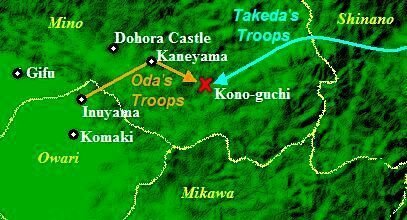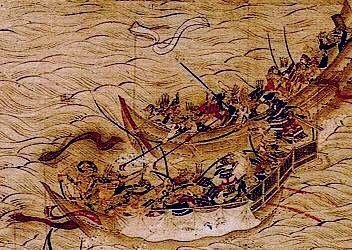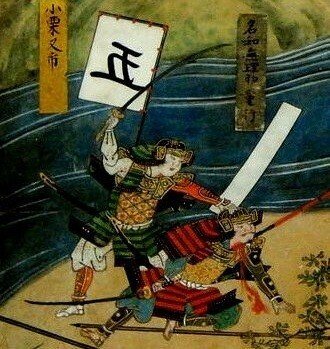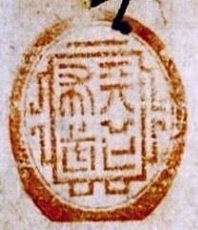
The Prize to Doke Brothers — Mizunami, September 1565

Oil on canvas, 38.0 × 45.5 cm, 2015-2022, M.Tsushima
Background
In 1564 Nobunaga established his rule of Owari Province by expelling his hostile relatives and taking Inuyama Castle. The Inuyama castle was located at the northern end of the Owari Province from where his army marched on the northern adjacent Mino Province ruled by Saito Clan. Meanwhile, the Mino Province was also the interest of Takeda Shingen who ruled its eastern adjacent Shinano Province.
The tension rose to the extent that a skirmish broke out between Oda and Takeda armies around 1565 at Kono-guchi in the eastern Mino Province, where Nobunaga's soldiers, Doke brothers, fought with Takeda's troops and took three enemies' heads as a proof of military success and brought them to Nobunaga. Nobunaga, finding the brothers wearing white banners, wrote on them "the best hero under the heaven".
Accounts
Ota Gyuichi(1527-1613), samurai who served Nobunaga, writes[1]:
There were brothers, Doke Seijuro, Doke Kojuro, from Owari Province, living in Moriyama. Several years ago, Takeda Shingen invaded Kono-guchi in the east of Mino Province. Then Mori Sanzaemon and Hida Genba took the lead in the battle, the armies fought in the mountains and valleys. The brothers took three enemies' heads and brought them to Nobunaga who exceptionally praised them. The brothers wore a white banner, on which Nobunaga handwrote "The Best Hero under The Heaven". Nothing is more honorable than this, the brothers were the people of honor.
Venue and Date
The inland Mino Province is mostly covered with mountains, where in the east of the province is a ruin of a castle called Kono Castle, aka. Tsuruga Castle in present Mizunami City. According to Ota Guichi's account, the battle with Takeda Shingen's troops was fought at Kono-guchi. Around the castle, therefore, is considered to be the battlefield.

The precise date is unknown. Ota Guichi's account writes about the event in the chronicle of 1570 where it writes that the event occurred several years ago. Nobunaga made peace alliance with Takeda by marrying his daughter to Takeda Shigen's son, Takeda Katsuyori, that was predated by sending an ambassador, Oda Tadahiro, to Takeda's headquarter in Kofu, on 2 October 1565[2]. Before that, on 22 September 1565, Mori Sanzaemon Yoshinari(1523-1570), who served Nobunaga, attacked Saito's Dohora Castle and captured it, and later in October was deployed at Kaneyama Castle[3]. Mori Yoshinari, while having battle with Saito Clan who was headquartered at Gifu, was at the same time to face Takeda Clan who had deployed his vassals in the eastern Mino Province. The battle of Kono-Guchi, therefore, would be fought in September 1565. Nobunaga then was thirty one years old.
Samurai's Banner
Samurai soldiers wore a banner to effectively show their achievement in the battlefield.
Samurais' banners date back to the 12th century when two major samurai clans, Minamoto and Taira fought for the rule of Japan. Minamotos wore white banners, Tairas red ones.
Since Minamotos defeated Tairas and established the first samurai government, Shogunate, in 1192, a blank white banner represents the legitimate samurai descendant of Minamoto family. The Minamotos banned other samurais to wear a blank white banner. In 1189 Satake Hideyoshi, a samurai from Hitachi Province, joined the army of Minamoto Yoritomo, who found Satake wearing a blank white banner, accused him of doing it, gave him a fan on which was painted a rising moon, and ordered him to put the fan above the blank white banner in order to distinguish it from the legitimate blank white banner of Minamoto Clan[4].

In the following centuries, a samurai banner was painted with a family crest to distinguish the soldier from enemies, as well to show his distinguished service in the battlefield. But that was not the rule. In the 16th century warfare, some of the banners were painted with Chinese characters, the others were painted with geometric patterns, or a mono-color including blank white which Minamotos already had no authority to limit the use of to their families.

Doke Brothers and the Banners of honor
Not much is known about Doke Brothers, partly because of their short lives. Doke Brothers' father, Doke Owarinokami, since his early age, served Nobunaga's father, Oda Nobuhide(1510-1551, r.1526 or 1527-1551). So the Doke Brothers might be the same age as Nobunaga or years younger. They were from Moriyama, Owari Province, five kilometers east of Nagoya, where Nobunaga had lived. Doke family, therefore, conceivably deeply connected to Oda family and served them in two generations.
In 1565, Doke Brothers served Nobunaga's military campaign in the eastern Mino Province, where they fought with Takeda Shingen's troops. In the mountain battle, they killed three enemy soldiers and brought their heads to Nobunaga, who found the brothers wearing white banners and wrote letters on them as a prize.
What Nobunaga wrote on their banners were seven characters:天下一之勇士也 (Ten Ka Ichi No Yu Shi Nari), meaning "The Best Hero under the Heaven".
What is noticeable is the first two letters: Ten Ka, that literally translates as "under the heaven" denoting the entire country.

It seems hyperbolic for a warlord who had just one province under his control to say that he had the best hero in the country. But his use of the word "Ten Ka" played significant role, around two years later, in 1567, when he began to use a red seal stamp on letters as a signature, which reads "Ten ka Fu bu", in manifesting his ambition to rule the whole country under samurai's control.

Why did Nobunaga, though a ruler of just 2 provinces out of 68 provinces in Japan, hold such an audacious ambition?
He at that time already had connected to the Imperial Court in Kyoto, thanks to Doke brothers' father, Doke Owarinokami, whose wife's brother was an imperial envoy, Tateri Munetsugu(1528-1622). Tateri, in 1564, visited Kiyosu Castle in Owari Province where he was introduced by Doke Owarinokami to Nobunaga and encouraged Nobunaga to come to Kyoto to restore the Imperial Court which had been dilapidated for 90 years[3].
Nobunaga was hoped not only by the Imperial Court but also by the Shogun family to restore order in Kyoto. The 13th Ashikaga Shogun, Ashikaga Yoshitel, was killed by hostile samurai warlords, Miyoshi Triumvirate, in 1565, and his brother Ashikaga Yoshiaki fled to Omi, where he was about to ask Nobunaga to come to Kyoto to restore the Shogunate.
Nobunaga had to secure the route to Kyoto which traveled across Mino and Omi provinces. Doke brothers who made an honor in the Mino Province, were to work hard also in Omi Province. In the battle against Azai Clan in Omi Province five years later in 1570, while Nobunaga's troops were outnumbered by Azai's troops, Doke brothers were killed in the battle. The best heroes, then, wore the banners of honor[1].
References
[1] 信長公記, 太田牛一
[2] 甲陽軍鑑 品第丗三 p128/265
[3] 金山記
[4] 吾妻鏡 第二 文治五年七月二十六日 p105/128
[5] 安徳天皇縁起絵図
[6] 長篠合戦図屏風 18世紀
